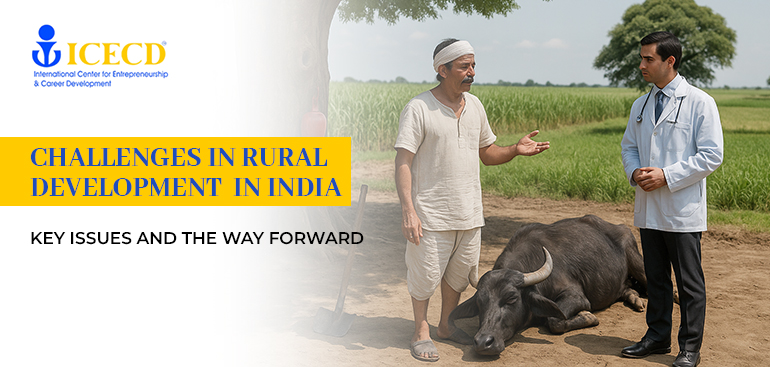India is a land of villages – with nearly 65% of its population living in rural areas. Yet, despite being home to the soul of the nation, rural India continues to grapple with deep-rooted development challenges. From poor infrastructure and low agricultural productivity to a lack of healthcare and limited education opportunities, the road to rural transformation is filled with obstacles.
Let’s explore the key challenges in rural development in India, their root causes, and possible solutions to create sustainable and inclusive growth.
1. Inadequate Infrastructure
One of the biggest hurdles in rural development is the lack of basic infrastructure:
- Road Connectivity: Many rural villages remain unconnected to main roads, especially in hilly or tribal areas, affecting transport, trade, and mobility.
- Electricity and Water Supply: Unreliable power supply and irregular access to clean water directly impact livelihoods and health.
- Digital Infrastructure: The digital divide excludes many from accessing online education, healthcare, banking, and government schemes.
2. Low Agricultural Productivity
Agriculture employs over 50% of the rural workforce, yet it suffers from:
- Outdated farming techniques
- Small and fragmented landholdings
- Poor irrigation facilities
- Lack of access to markets and fair pricing
With agriculture forming the backbone of rural economies, revamping agrarian systems is crucial for rural prosperity.
3. Limited Access to Quality Education
Rural areas often lack:
- Qualified teachers
- Modern teaching tools
- English-medium schools
- Vocational or entrepreneurial education
This education gap leads to low literacy rates, school dropouts, and poor employability among rural youth.
4. Unemployment and Underemployment
Despite various rural employment schemes, joblessness remains a pressing concern:
- Over-reliance on agriculture leads to seasonal employment
- Lack of skill training and industrial exposure limits opportunities
- Informal employment with low wages and no security is rampant
5. Poor Healthcare Facilities
Challenges in rural healthcare include:
- Shortage of doctors and paramedical staff
- Inadequate PHCs (Primary Health Centres)
- Poor maternal and child health services
- Lack of awareness and access to insurance
This directly impacts productivity, life expectancy, and quality of life in rural regions.
6. Gender Inequality
Rural women face barriers in:
- Education
- Employment
- Land ownership
- Participation in decision-making
Cultural norms and limited mobility further restrict their access to resources.
7. Social Inequality and Caste Discrimination
Social hierarchies and discrimination hinder equal access to:
- Education
- Employment
- Welfare schemes
Scheduled Castes (SC), Scheduled Tribes (ST), and other marginalized groups are often excluded from development benefits.
8. Environmental Degradation
Rural livelihoods – especially agriculture and animal husbandry – are highly dependent on natural resources. This also results in:
- Deforestation
- Soil degradation
- Water scarcity
- Climate change
All these pose major threats to sustainable rural development.
9. Governance and Implementation Gaps
Well-meaning rural development schemes often suffer due to:
- Corruption
- Bureaucratic delays
- Lack of local participation
- Poor monitoring and evaluation
Conclusion
Rural development is not a one-size-fits-all approach – it requires locally-driven, inclusive, and sustainable models. ICECD plays a crucial role in addressing these challenges by:
- Empowering rural youth and women through entrepreneurship
- Bridging the gap between policy and practice
- Facilitating education, healthcare, and livelihood opportunities
- Strengthening local institutions and community ownership
As we move towards achieving the Sustainable Development Goals (SDGs), rural India must not be left behind. Solving these challenges is not only a moral imperative but a strategic necessity for India’s overall progress.


